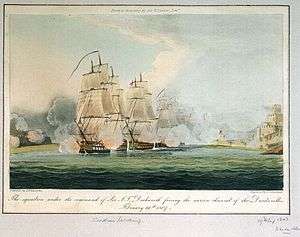HMS Meteor (1803)
| History | |
|---|---|
| Name: | Sarah Ann |
| Builder: | ?, Newcastle |
| Launched: | 1800[1] |
| Name: | HMS Meteor |
| Acquired: | October 1803 |
| Fate: | Sold on 28 May 1811 |
| General characteristics [2] | |
| Class and type: | bomb vessel |
| Tons burthen: | 364 (bm) |
| Length: |
|
| Beam: | 29 ft (8.8 m) |
| Depth of hold: | 12 ft 11 in (3.9 m) |
| Propulsion: | Sails |
| Complement: | 67 |
| Armament: | 8 x 24-pounder carronades + 1 x 13" mortar + 1 x 10" mortar |
HMS Meteor was a bomb vessel of the Royal Navy. She was previously the merchant vessel Sarah Ann, which the Admiralty purchased in October 1803. She conducted bombardments at Havre de Grâce, the Dardanelles, and Rosas Bay, on the Catalan coast. She was sold in 1811.
Service
Meteor was commissioned in December 1803 under Commander James Masters.[2] In May 1804 Commander Joseph James replaced Masters. She then participated in the bombardments of Le Havre on 23 July 1804 as part of a squadron under Captain R. Dudley Oliver of Melpomene. At one point during the bombardment Meteor had to resupply two of her fellow bomb vessels, Explosion and Zebra with shells and powder. Over two days the bomb vessels conducted over four hours of bombardment, firing over 500 shells and carcasses into Le Havre and setting fires in the town.[3] Meteor shared with the rest of the squadron in the prize money after Favourite captured the Shepherdess on 21 July,[4] and after Explosion captured the Postilion on 31 July.[5]
Next, and 1 August 1804, Meteor participated in a bombardment of Boulogne.[6] She also participated is several actions off Boulogne.
On 13 April 1805, Meteor captured the Kniphausen ship Brant.[7] On 30 May 1805, Meteor was in company with Entreprenant when they captured the Prussian sloop Omnibus.[Note 1]
In October Meteor come under the command of James Collins.[2] On 15 November Meteor was in company with the gun-brig Speedwell when they captured the American brig Venus.[9]

Collins sailed Meteor to the Mediterranean on 10 January 1807.[2] There, Meteor was a member of Admiral Sir John Duckworth's Dardanelles expedition against the Turks. She had the misfortune to burst her 13-inch mortar while forcing a passage through the Dardanelles, and her 10-inch mortar on the way back. During the action on 3 March Meteor suffered eight men wounded, including one badly.[10]
Although details are missing, Meteor apparently next participated in an attack on batteries and gun-boats in the Bay of Naples.[6]
From about 6 November 1808 on, still under Collins's command, Meteor took part in the defense of the Ciutadella de Roses and Fort Trinidad (Castell de la Trinitat) at Rosas Bay in northeastern Spain. She was in company with the Third Rate Excellent under Captain John West. Gunfire and bombardment from Excellent and Meteor helped repel several French attacks, and a landing party of Marines and seamen reinforced the Spanish garrisons.[11] The bomb vessel Lucifer and the Third Rates Fame and Magnificent arrived later, with the frigate Imperieuse under Captain Lord Cochrane joining the defense towards the end of November. Despite British assistance, the citadel capitulated to the French on 5 December. Cochrane, seeing that further resistance was useless, blew up the magazines at Trinity Castle and withdrew together with his landing party.[12] In the fighting on 7 and 20 November, eight men on Meteor were wounded, one, a Royal Marine gunner, losing both arms. Meteor also took on board the Spanish governor, who had been wounded.[11]
Meteor sailed to the Dalmatian coast, where her boats cut out a privateer.
Fate
Meteor was paid off into ordinary in June 1810, and Collins was promoted to post-captain on 21 October 1810.[13] She was sold on 28 May 1811.[2]
Footnotes
- Notes
- Citations
- ↑ "NMM, vessel ID 371397" (PDF). Warship Histories, vol ii. National Maritime Museum. Retrieved 30 July 2011.
- 1 2 3 4 5 Winfield (2008), p.374.
- ↑ The London Gazette: no. 15725. p. 938. 4 August 1804.
- ↑ The London Gazette: no. 15899. p. 345. 15 March 1806.
- ↑ The London Gazette: no. 15848. p. 1248. 1 October 1805.
- 1 2 O'Byrne (1849), Vol. 1, p.26.
- ↑ The London Gazette: no. 16435. p. 2008. 15 December 1810.
- ↑ The London Gazette: no. 15969. p. 1413. 25 October 1806.
- ↑ The London Gazette: no. 16269. p. 946. 24 June 1809.
- ↑ The London Gazette: no. 16026. pp. 593–597. 5 May 1807.
- 1 2 The London Gazette: no. 16224. pp. 129–131. 28 January 1809.
- ↑ The London Gazette: no. 16235. p. 307. 7 March 1809.
- ↑ Marshall (1828), Supplement - Part 2, p.206.
References
- Colledge, J. J.; Warlow, Ben (2006) [1969]. Ships of the Royal Navy: The Complete Record of all Fighting Ships of the Royal Navy (Rev. ed.). London: Chatham Publishing. ISBN 978-1-86176-281-8. OCLC 67375475.
- Marshall, John (1823-1835) Royal naval biography, or, Memoirs of the services of all the flag-officers, superannuated rear-admirals, retired-captains, post-captains, and commanders, whose names appeared on the Admiralty list of sea officers at the commencement of the present year 1823, or who have since been promoted ... (London: Longman, Hurst, Rees, Orme and Brown).
- O'Byrne, William R. (1849) A Naval Biographical Dictionary: comprising the life and services of every living officer in Her Majesty's navy, from the rank of admiral of the fleet to that of lieutenant, inclusive. (London: J. Murray), vol. 1.
- Winfield, Rif (2008). British Warships in the Age of Sail 1793–1817: Design, Construction, Careers and Fates. Seaforth. ISBN 1-86176-246-1.
This article includes data released under a Creative Commons Attribution-ShareAlike 3.0 Unported UK: England & Wales License, by the National Maritime Museum, as part of the Warship Histories project